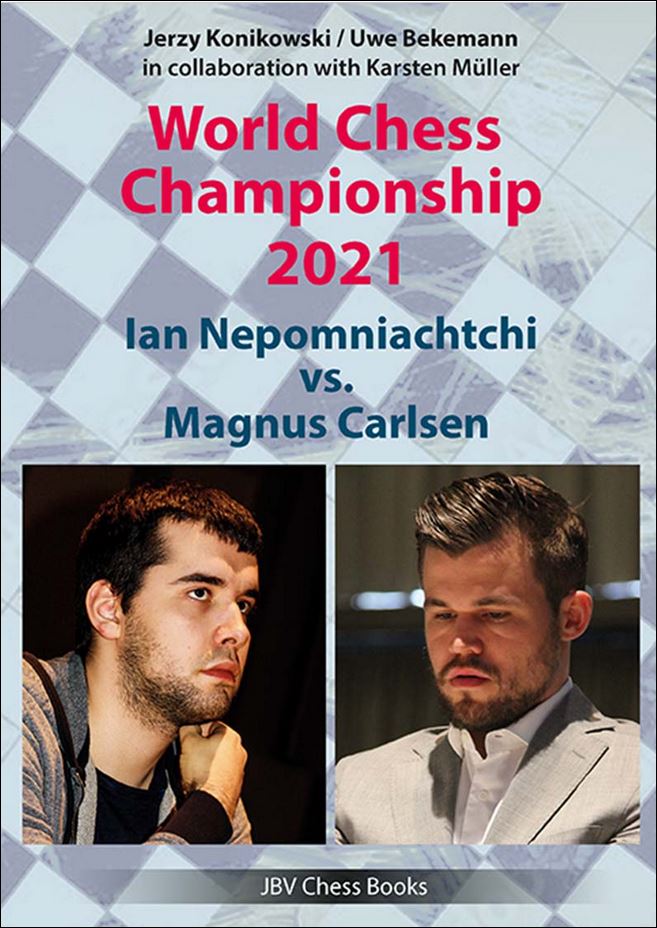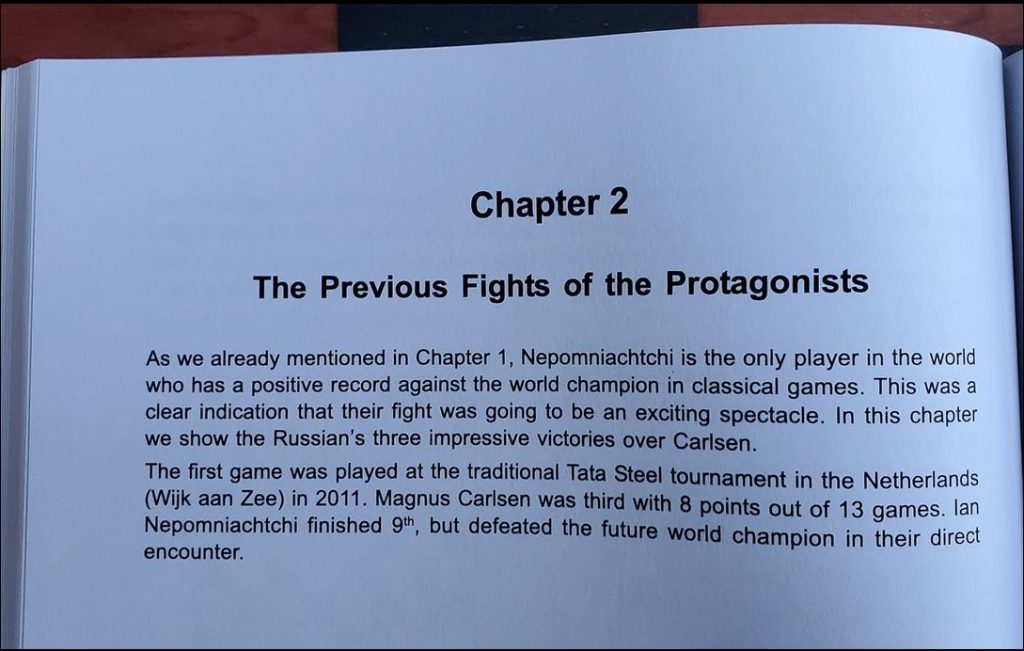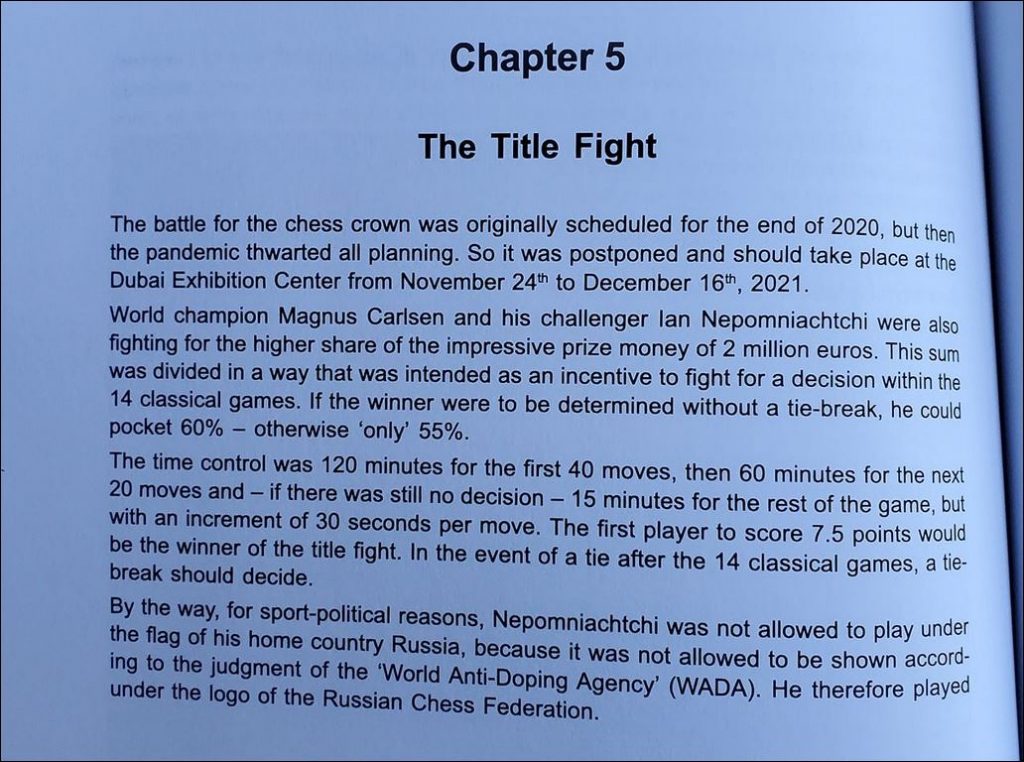
In today’s world where everything can be seen over the internet, do we still need books?
Especially a book about a world championship in which we saw the challenger, who many thought could win and bring back the title to Russia, crumble in just 11 games?
The answer is a resounding yes. This book gives many different perspectives. For example while watching the games, I realized the depth of Carlsen’s preparation. The annotators showed how some lines happened in the past in other Carlsen’s games. Magnus had to know them, and eventually have worked on them with improvements. Definitely a lot of work!
This book also shows how chess is a sport. Carlsen domination is something unheard of. For example at this point if mastodontic and slow institutions like FIDE (or for US the USCF) would acknowledge we are in a different era, an entertainment age (Netflix with the Queen’s Gambit series has shown how to get over 60 million people interested in chess over night!), they could create different formats for the world championship, and keep everyone interested. They would also receive money from sponsors in amounts they never had before, and of course bring more general public into our beloved sport!

Luckily for us: “for profit” chess sites and “non profit” chess sites are in fact bringing more laymen to play chess. In fact one of the latest online tournaments I followed on Lichess, and was only for players above a rating of 2000, had something like 96000 games played in the couple of hours it was running.
Coming to review the book, in about 160 plus pages, there are five chapters, which quite well describe what one should know about this world championship and the two players.
The book itself can entertain when replaying the games over the board, or improve our chess thanks to a chapter dedicated to positions coming from the games of these two great players.

Chapter One: gives a short portrait of the opponents. The first one is Nepo, to which are dedicated 5 games deeply analyzed and then Magnus with another 5 games deeply analyzed. Nepo’s portrait is quite important, because a layman could think he wasn’t really good at chess, from the way he lost in this world championship. Instead in this chapter we discover he learned the game when he was 4. He won many titles like European Champion U10, twice the European Champion U12, then U12 and U16 World championship titles. For those who don’t know, these young prodigies are already master level players at 10. This is one of the problems many veteran tournament players have to deal with today. They face these little angels, who sometimes need to stand up to play, because they cannot reach well the board when sitting, but who are already computers at the age of 10-12. The result is catastrophic for the older players who get eaten in few bites.
Magnus portrait is short, honestly to make a fair portrait of the highest rated player in history, and the one who by this point is also the greatest, would definitely need a minimum 300 pages book. However there are already on the market many books on Magnus style, methods, openings, games etc.

Chapter Two: this was the chapter I was really interested reading when getting this book. These two amazing chess players have met many times before over the board in different tournaments. The previous positive results by Nepo created the prediction that he could be better than Caruana, and actually take the title.
Maybe Russia should have paid Caruana to play a secret match with Nepo before sending him to be eaten by the Lion.
Chapter Three is a nice idea for a world championship book. The authors have gathered 24 positions taken from Carlsen and Nepo’s games and created a test for the reader.

Chapter Four: is made by interviews GM Mueller, GM Marin and FM Krause.

And finally we reach Chapter Five which is the chapter showing the games played for the World Champion Title.
Game 6 is what turned this world championship into a historical event.
This is also the game which proves chess is a sport, especially at this level, and one needs to be young and definitely in a physical shape as most sportsmen are in their respective fields.
8 hours of fighting with over 130 moves. Please try just for humoring this writer, try to play chess 8 hours non-stop and see what you feel, how tired you’ll be… and then imagine these two fighters… this was probably also the game where the World Champion Carlsen, showed the challenger there was no way he would get the throne!
One can feel the last games in the match show how Carlsen is crushing the challenger.
Chess at this top level is more than memorization of long variants, or knowledge of endgames, it is an extreme and very violent sport. Only one survives at the end of the day. The annihilation of the opponent is not on the outside, but on the inside!
Pro and Con: I found the book quite interesting, because the authors went to look through a myriad of recent internet games, to comment and annotate on the one included in the book. The average chess player, rated less than 2000, could dismiss blitz games as non important for learning. But here we have the top 10-50 players regularly using blitz tournaments online to test opening ideas. Ideas they will eventually use in tournament games, creating a new edge of opening theory! If we add these players are all above 2700-3000 rating in blitz, while the average amateur has difficulty to reach 2000 online, we do understand such games do have a level of chess understanding the 99% of online players don’t have, I’ve seen the authors find games of the top chess players like Firouzja, Caruana, So, Giri, etc. played on all the three main chess sites! Yes, the price of the book covers a research an average chess player wouldn’t be able to do.
As reader I’d like to know why a professional like Nepo, and like everyone who is in the top 10, and their meaning in life is to become world champion, couldn’t or wasn’t in “shape” (at least this is the excuse given). Why someone who is Russian and has access to at least 50 or more years of world championships and relative literature and lore, strangely didn’t prepare well for this world championship. Of course one could put it in a nationalist theme, and ask why Russia didn’t help this guy till things were going definitely too bad to recover.
On one side we know Carlsen’s prep, it seems he got the flu and since he was stuck in a room, he played something like 2-3000 bullet games non-stop, probably trying to emulate Alpha-Zero playing million of games to learn chess. He also had a great team for sparring, and finding new theoretical novelties to sprung into the match!
Final Thoughts: A school of thought on chess improvement says we should watch all the chess games played in world championship matches to become master level players. However, without the guidance on what to look for in those games, it would become quite tough to understand chess, especially the latest world championships, in which challenger and World Champion are more machines than humans, and they have a technical skill level the 99.9% of humankind doesn’t have. Hence the need of books like this one which help us understand what’s going on, and give us a glimpse of what a 2800 rated player thinks and evaluates a position. This book could be difficult to find, if one is not a chess books collector, because I couldn’t find it on Amazon or the New in Chess bookshop, but directly from a German site which sells for this publisher, here the link: https://www.schachversand-ullrich.de/literatur/partiensammlungen-und-turniere/in-englischer-sprache/4262/konikowski-bekemann-mueller-world-chess-championship-2021-ian-nepomniachtchi-vs.-magnus-carlsen

Always for collectors, this publisher has made a book about previous world championships, in the same format of this book, which could be interesting to have. Here the link for the 2018 World Championship with Caruana:

And this is the link for the 2016 against Karjakin:

Pingback: Szachy w moim życiu.: Nowe książki w Joachim Beyer Verlag (32)
John Christopher Simmons